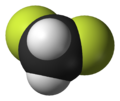Top Qs
Timeline
Chat
Perspective
Difluoromethane
Chemical compound From Wikipedia, the free encyclopedia
Remove ads
Difluoromethane, also called HFC-32 or R-32, is an organofluorine compound with the formula CH2F2. It is a colorless gas that is used as a refrigerant. As a hydrofluorocarbon, R-32 is being phased out in the EU.[2]
Remove ads
Synthesis
Difluoromethane is produced by the reaction of dichloromethane and hydrogen fluoride (HF) using SbF5 as a catalyst.[3]
- CH2Cl2 + 2 HF → CH2F2 + 2 HCl
Applications
Difluoromethane is used as refrigerant that has prominent heat transfer and pressure drop performance, both in condensation and vaporization.[4]
Difluoromethane is currently used by itself in residential and commercial air-conditioners in Japan, China, and India as a substitute for R-410A. In order to reduce the residual risk associated with its mild flammability, this molecule should be applied in heat transfer equipment with low refrigerant charge such as brazed plate heat exchangers (BPHE), or shell and tube heat exchangers and tube and plate heat exchangers with tube of small diameter.[5] Many applications confirmed that difluoromethane exhibits heat transfer coefficients higher than those of R-410A under the same operating conditions but also higher frictional pressure drops.[5]
Other uses of difluoromethane include its use as aerosol propellant and blowing agent.
Remove ads
Environmental effects
The global warming potential (GWP) of HFC-32 is estimated at 677 on a 100-year time window.[6] This is far lower than the GWP for HFC refrigerants[which?] it is replacing, but remains sufficiently high to spur continued research into using lower-GWP refrigerants.
Difluoromethane is excluded from the 1963 list of VOCs restricted by the United States Clean Air Act due to the ODP being zero.[6]
European Union phase-out
In order to reduce greenhouse gas emissions, the European Union passed a law aiming at phasing out several high-GWP hydrofluorocarbon refrigerants, including R-32. Sale of R-32-based domestic refrigerators are banned from 1 January 2026, and air conditioners and heat pumps from 2027 to 2030, depending on capacity and equipment type. [2]
Replacements being considered are:
- R290 (propane) - highly flammable and not suitable for many residential installation. Manufacturers are also trying to restrict DIY installations of it, which increases costs.
- R454C - a mix of 21.5 percent R-32 and 78.5 percent R1234yf. This is under the 150GWP limit, but has a worse COP Additionally R1234yf can decompose into the highly toxic forever chemical TFA.
- R744 (carbon dioxide) - engineering challenges remain because the cost is too high for residential use.
Remove ads
References
See also
External links
Wikiwand - on
Seamless Wikipedia browsing. On steroids.
Remove ads



